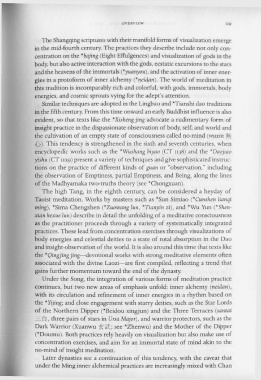Page 159 - The Encyclopedia of Taoism v1_A-L
P. 159
OVERVIEW II9
The Shangqing scriptures with their manifold forms of visualization emerge
in the mid-fourth century. The practices they describe include not only con-
centration on the *bajing (Eight Effulgences) and visualization of gods in the
body, but also active interaction with the gods, ecstatic excursions to the stars
and the heavens of the immortals (*yuanyou), and the activation of inner ener-
gies in a protoform of inner alchemy (*neidan). The world of meditation in
this tradition is incomparably rich and colorful, with gods, immortals, body
energies, and cosmic sprouts vying for the adept's attention.
Similar techniques are adopted in the Lingbao and *Tianshi dao traditions
in the fifth century. From this time onward an early Buddhist influence is also
evident, so that texts like the *Xishengjing advocate a rudimentary form of
insight practice in the dispassionate observation of body, self, and world and
the cultivation of an empty state of consciousness called no-mind (wuxin ~
(,\). This tendency is strengthened in the sixth and seventh centuries, when
encyclopedic works such as the *Wushang biyao (CT 1138) and the *Daojiao
yishu (CT 1129) present a variety of techniques and give sophisticated instruc-
tions on the practice of different kinds of guan or "observation," including
the observation of Emptiness, partial Emptiness, and Being, along the lines
of the Madhyamaka two-truths theory (see *Chongxuan).
The high Tang, in the eighth century, can be considered a heyday of
Taoist meditation. Works by masters such as *Sun Simiao (*Cunshen lianqi
ming) , *Sima Chengzhen (*Zuowang lun, *Tianyin zi), and *Wu Yun (*Shen-
xian kexue lun) describe in detail the unfolding of a meditative consciousness
as the practitioner proceeds through a variety of systematically integrated
practices. These lead from concentration exercises through visualizations of
body energies and celestial deities to a state of total absorption in the Dao
and insight-observation of the world. It is also around this time that texts like
the *Qingjingjing-devotional works with strong meditative elements often
associated with the divine Laozi-are first compiled, reflecting a trend that
gains further momentum toward the end of the dynasty.
Under the Song, the integration of various forms of meditation practice
continues, but two new areas of emphasis unfold: inner alchemy (neidan),
with its circulation and refinement of inner energies in a rhythm based on
the *Yijing; and close engagement with starry deities, such as the Star Lords
of the Northern Dipper (*Beidou xingjun) and the Three Terraces (santai
.:::: ~ , three pairs of stars in Ursa Major), and warrior protectors, such as the
Dark Warrior (Xuanwu "R JE.\:; ; see *Zhenwu) and the Mother of the Dipper
(*Doumu). Both practices rely heavily on visualization but also make use of
concentration exercises, and aim for an immortal state of mind akin to the
no-mind of inSight meditation.
Later dynasties see a continuation of this tendency, with the caveat that
under the Ming inner alchemical practices are increasingly mixed with Chan

